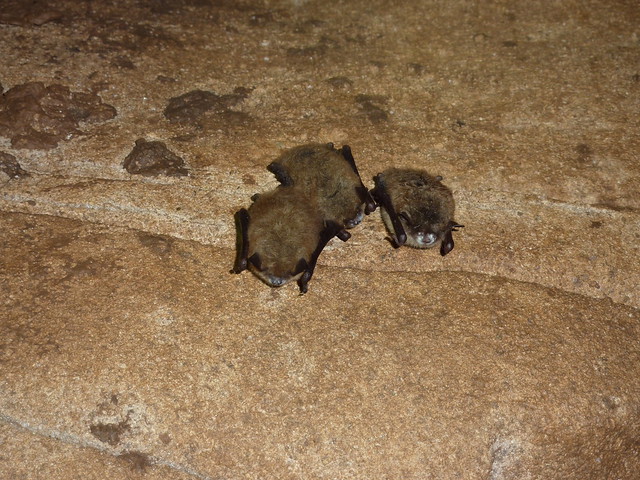TOP STORIES
Fatal bat disease confirmed in Kentucky The Kentucky Department of Fish and Wildlife Resources (KDFWR) and the U.S. Fish and Wildlife Service (USFWS) have detected the presence of white-nose syndrome (WNS) in Trigg County, in southwest Kentucky.
The Kentucky Department of Fish and Wildlife Resources (KDFWR) and the U.S. Fish and Wildlife Service (USFWS) have detected the presence of white-nose syndrome (WNS) in Trigg County, in southwest Kentucky.
A suspect little brown bat from a cave in Trigg County, about 30 miles southeast of Paducah, Ky., was submitted to the Southeastern Cooperative Wildlife Disease Study (SCWDS) in Athens, Ga., who confirmed the disease.
... Kentucky was the first state to develop a response plan to address WNS both before and after its arrival in the state.
Almost 100 hibernacula were checked throughout Kentucky during the winter. The Trigg County cave was one of five revisited by scientists upon confirmation of WNS in Ohio. These hibernacula were rechecked due to their known proximity to infected sites in adjacent states. The privately-owned Trigg County cave is used as a hibernaculum by six species, including the endangered Indiana bat, and is a summer roost for the endangered gray bats.
Surrounding caves were checked within a 16 mile radius and no additional infected sites were found. Measures were taken to limit the spread of WNS beyond the Trigg County cave that is regularly used as a hibernaculum by more than 2,000 bats. These included removing and euthanizing 60 highly suspect little brown bats and tri-colored bats as they were not expected to survive.
Bats collected will be used to provide critical information to researchers. Under the direction of KDFWR’s veterinarian, Dr. Aaron Hecht, staff from SCWDS collected samples from the bats. “A better understanding of the disease process will enhance our ability to respond to outbreaks,” said Hecht.
13 Apr 2011
Location: Paducah, Kentucky, USA - Map It

 ]
]>>> Study: Bat disease may increase farm pesticide use
>>> Some bat caves reopen to visitors [Columbia, Missouri, USA]
16 dolphins washed ashore dead in Pondy
Sixteen long-nosed dolphins were washed ashore dead at three places along the Puducherry coast on Monday. It has raised concern among environmentalists as it is the 20th instance in 16 months of protected marine mammals being washed ashore dead or alive.
On an average, about 250 dolphins are washed shore dead or alive every year, said Dr R S Lal Mohan, retired principal scientist of the Central Marine Fisheries Research Institute (CMFRI).
A team of officials led by deputy conservator of forests Dr A Anil Kumar visited the hamlets and inspected the dead mammals. Veterinary doctors conducted postmortem examinations and buried 15 dolphins. One carcass was sent to Rajiv Gandhi College of Veterinary Sciences here for detailed analysis.
The dolphins measured between two-and-a-half feet and five feet. Ten were females of which two were found to be pregnant.
Experts in the veterinary college here will undertake further histopathological studies to ascertain the cause of death. The forest department will also seek the opinion of the scientists at CMFRI in Chennai. "Our analysis revealed that the mammals did not suffer from major diseases and only a detailed analysis will throw more light on the cause of death," Kumar said.
13 Apr 2011
OIE Final Report: Avian influenza, Israel, H5N1
- A Marsh Harrier (Circus aeruginosus) with respiratory signs was found in the wild. It was brought to the wildlife veterinary hospital where it died a few hours afterwards. The body was sent to the Avian Laboratory of the Kimron Veterinary Institute. Note by the OIE Animal Health Information Department: This outbreak is located into Israeli Settlements in the West Bank.
- The sick bird had no contact with other birds since it was discovered till its death. The cage has been disinfected. Some other wild birds, staying in the Wildlife Veterinary Hospital, were sampled and put under quarantine.
11 Apr 2011
Location: Jericho, Israel - Map It

OTHER WILDLIFE HEALTH RELATED NEWS
Photo courtesy of Science Daily

- In recent decades, the number of alien species in Navarre has tripled [Spain]
- Penguins That Shun Ice Still Lose Big from a Warming Climate
- Year after Gulf oil spill, group gives mixed report card for wildlife
- Lake Powell blue-green algae sparks health warning [Australia]
- Officials continue watch for Chronic Wasting Disease [West Virginia, USA]
- Mobile lab helps EPA analyze St. Clair Shores PCB outbreak faster and more efficiently [Michigan, USA]
- Fans Can View Falcon Chicks Even As they Grow This Spring [New York, USA]




